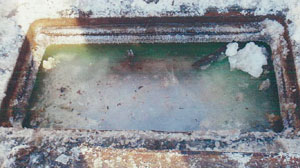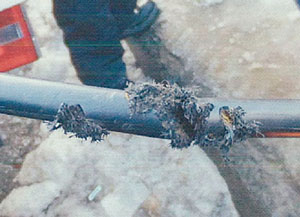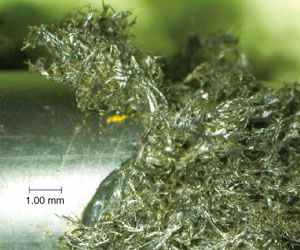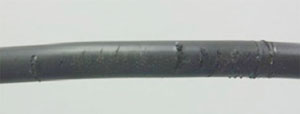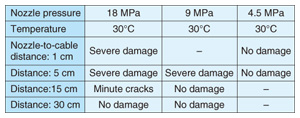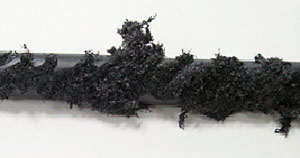 |
|||
|
|
|||
|
Practical Field Information about Telecommunication Technologies Vol. 10, No. 6, pp. 42–44, June 2012. https://doi.org/10.53829/ntr201206pf1 Cable Damage during Deicing of a HandholeAbstractThis article introduces a case study of cable damage during the deicing of a handhole and offers recommendations for damage-free deicing. It is the eleventh in a bimonthly series on the theme of practical field information about telecommunication technologies. This month's contribution is from the Materials Engineering Group, Technical Assistance and Support Center, Maintenance and Service Operations Department, Network Business Headquarters.
1. IntroductionNTT telecommunication facilities are deployed far and wide throughout Japan. They include many manholes, handholes, and similar facilities where water can easily accumulate, and in cold regions, may freeze during the winter months. This article introduces a case study of deformation and damage to the outer sheath of an optical cable that occurred during deicing of the interior portion of a frozen handhole in a cold region of the country to enable maintenance work to be performed. 2. Circumstances and inspection2.1 BackgroundIn February 2011, a company associated with the electrical power system was deicing an NTT handhole located in a mountainous area. During this work, the plastic portion of the sheath covering an NTT optical cable (40SM-WBB) was deformed into fibrous threads and the cable itself was damaged not only on its surface but also in its inner portion to the extent of an open cut (Figs. 1 and 2). This deicing was carried out using typical deicing tools (such as scrapers and sharp-edged tools) and a high-pressure water sprayer (water temperature: 30°C; nozzle pressure: 18 MPa).
2.2 InspectionAs shown in Fig. 2, the outer sheath of the cable was severely damaged at a particular section that turned fibrous. A magnified view of the damaged section taken with a microscope is shown in Fig. 3. Apart from this section, the cable did not incur any damage, and since the boundaries of the damaged section were clearly discernible, it was surmised that the damage was caused by localized application of external physical force.
3. Damage-cause investigation and damage-reproduction experiment3.1 Destructive test using a sharp-edged toolSince the mechanical outer damage might have been caused by deicing tools, we guessed that the deicing in this case was performed using either a sharp-edged tool conveniently at hand or a special-purpose deicing scraper onsite. However, when we scraped at the outer sheath of the cable using a saw-like tool, we found that only simple cuts were formed without any fibrous threads (Fig. 4).
3.2 Destructive test using a high-pressure water sprayerNTT-related business operators perform the same kind of deicing operation by spraying unpressurized warm water at a temperature of about 60°C. However, because a high-pressure water sprayer was used at the time of the accident, we decided to use a machine of the same type in an experiment designed to try and reproduce the damage. Specifically, we used a high-pressure water sprayer (Seiwa Sangyo jet-boiler/jet-clean product) to spray a new 40SM-WBB cable on the premises of the Technical Assistance and Support Center (Fig. 5). In this experiment, we varied two parameters: the nozzle pressure and the distance between the nozzle and cable. The results are given in Table 1.
Initially, we set the water temperature to about 30°C and nozzle pressure to 18 MPa and reproduced the working conditions at the site of the accident. We found that spraying the cable with water for 15 s from a distance of 5 cm damaged the outer sheath of the cable turning it fibrous, as shown in Fig. 6. From this result, we concluded that deicing performed using a high-pressure water sprayer was the cause of the damage in this incident.
We then performed additional testing to determine what usage conditions and usage method would avoid causing such damage. We found that when the nozzle-to-cable distance was 15 cm, minute cracks appeared; however, when the distance was 30 cm, no damage occurred. This led us to conclude that damage can be prevented in future if the distance from the nozzle to the ice (cable) is 30 cm or greater. We did not observe any major changes in the damage produced when the nozzle pressure was reduced to 9 MPa, but we found that no damage occurred when it was reduced to 4.5 MPa, even when the ice was sprayed at close range. Thus, while this experiment does not constitute detailed testing, the results indicate that no cable damage will occur at pressures at or below a certain value. 4. Summary of findingsFrom our experimental results, we conclude that using a high-pressure water sprayer to deice a handhole can damage a cable and turn its outer sheath fibrous. We also found that such damage can be avoided by reducing the pressure of the high-pressure water sprayer to 4.5 MPa or setting the distance from the nozzle to the cable to 30 cm or greater. However, as actual conditions may differ depending on equipment specifications such as the shape of the nozzle tip, it is not possible to firmly establish safe parameters for using a high-pressure water sprayer. We therefore recommend that the use of a high-pressure water sprayer be avoided if at all possible. In short, we strongly recommend that the deicing of telecommunications facilities containing NTT cables should be done by spraying with unpressurized warm water (about 60°C). This method conforms to the standard NTT deicing procedure. 5. ConclusionThis article presented a case study of cable damage in a cold region in Japan. We hope that the information provided here has enhanced our reader's understanding of material deterioration. Various telecommunications facilities suffer deterioration or damage in addition to the handholes described here. Please feel free to consult with NTT EAST Technical Assistance and Support Center in the event of a facility fault or deterioration-related problem with an unknown cause. |
|||









